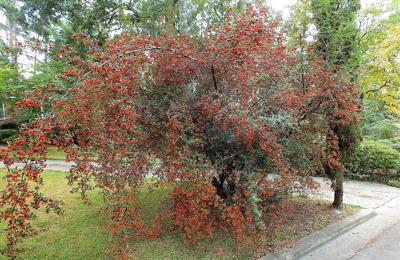Here is a shrub I never gave much thought to. I would see the pretty clusters of white flowers amongst the shiny dark green leaves in the spring and the bright orange red berries in the fall and winter, but all I ever remember are those one-half to three-fourths inch thorns.
They left their mark on you if were not careful. This shrub grows in the desert southwest, where most of us considered it invasive, and all the way through the south to Florida (Zones 5 to 9). It is native to Asia and Europe.
In the USA, there are about 10 different varieties with varying ability to withstand the cold. They bear clusters of small round berries which can be different intensities of yellow, orange and red. Likewise the size of these shrubs can vary from ground cover to compact, small leafed plants about three feet high to sprawling 12 feet tall and wide or even columnar upright tree like of many feet tall.
Pyracantha is an adaptable plant for hedges, espaliering or stand-alone planting. With those thorns, they can be a defense against intruders to your property.
They do prefer a sunny spot with well-drained soil, but will tolerate a part shady area. They also don’t like to be moved or their roots disturbed once they have established themselves in their “spot.”
Be sure to water Pyracantha at least once a week and soak one inch deep if rain is not in the forecast. Wear proactive clothing, long sleeves, long pants, gloves and maybe protective eye wear when planting or moving this plant-it’s those sharp thorns!
For the most part, it resists most pests and diseases, but scale, lace bugs, and spider mites can affect your Pyracantha. Fireblight can cause dieback of leaves and stems. Prune those infected areas and dispose of them to control the pests.
You can prune your Pyracantha in the spring after it finishes blooming to maintain a shape or size you desire.
In the winter, Pyracantha is like a magnet for birds and wildlife when food is scarce. If you are trying to establish a backyard habitat to help native birds, insects and wildlife survive, then you need Pyracantha as one of your helpful plantings.
All comments are welcome.





